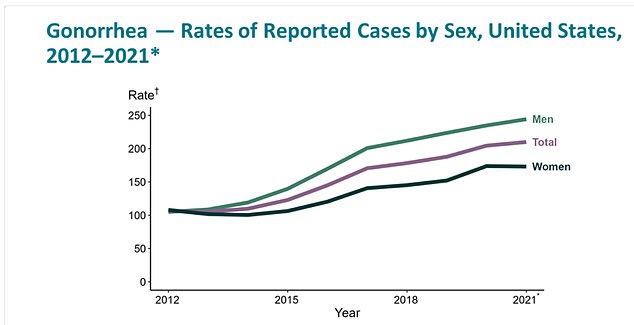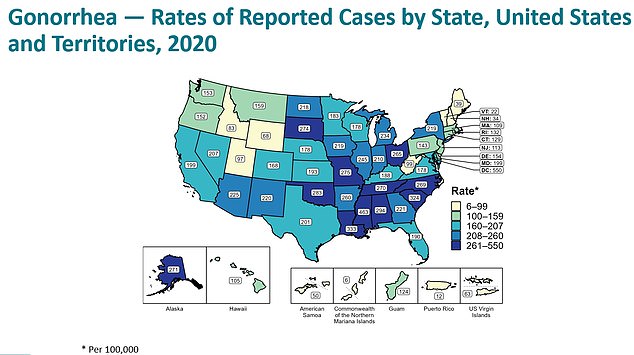China, known as ground zero of the Covid pandemic, may be driving a global surge of a new infectious disease: super gonorrhea.
According to a new CDC report, up to 98 percent of bacteria samples taken from STD patients in 13 Chinese provinces had the ability to evade first-line antibiotics.
Gonorrhea had been effectively evading medications for years, but the main concern among researchers is that China is reporting rates of a strain resistant to one of the last remaining effective antibiotics that are 40 times higher than those in the United States, United Kingdom and Canada.
The bacteria that cause gonorrhea have excelled in their ability to avoid antibiotics, to the point that the only recommended treatment left is ceftriaxone.

According to a CDC report, China is reporting rates of a strain resistant to one of the last remaining effective antibiotics that are 40 times higher than those reported in the US, UK and Canada.


Gonorrhea has increased in the US since 2012, with rates in men per 100,000 increasing considerably more than in women.
In 2022, CDC-affiliated researchers in China collected more than 2,800 Bacterial samples from patients with gonorrhea.
More than 97 percent of the samples were resistant to the drug ciprofloxacin, commonly known as Cipro, while 78 percent resisted treatment with penicillin, another ubiquitous antibiotic.
About 17 percent of the samples were resistant to azithromycin and cefixime, while eight percent were immune to the current standard treatment, ceftriaxone.
The percentage of strains of gonorrhea bacteria resistant to ceftriaxone has increased from 2.9 percent to 8.1 percent, much higher than reported in other countries.
For example, in the United Kingdom in 2022, only 0.21 percent of strains showed reduced susceptibility to ceftriaxone.


Gonorrhea is caused by a bacteria that is increasingly able to evade standard antibiotic treatment, making it a growing threat to global public health.


The map above shows gonorrhea rates in the 50 U.S. states, the District of Columbia, and the territories in 2020, the latest available.
CDC data showed that in the US, only about 0.2 percent of strains had increased resistance to ceftriaxone between 2016 and 2020.
In Canada, from 2017 to 2021, the ceftriaxone resistance rate remained relatively stable at around 0.6 percent.
The researchers said: “These findings underscore the urgent need for a comprehensive approach to tackling antibiotic-resistant N. gonorrhoeae in China, including identifying the factors that contribute to this high rate of resistance.”
China was only the second country to document a case of ceftriaxone-resistant gonorrhea in 2016, after Japan identified one in 2009.
With rates of antibiotic resistance rising, new medications will always be needed to combat infections.
Gonorrhea is spread through sexual contact with the penis, vagina, mouth, or anus of an infected partner.
It can also be transmitted perinatally from mother to baby during childbirth.
In most cases, it is not a fatal condition, although if left untreated it can develop into a more serious inflammatory problem that causes pain in the pelvic area and even infertility.
Historically, penicillin has been the first-line treatment, but due to widespread resistance, its use has declined.
Ciprofloxacin and other fluoroquinolones then replaced penicillin as the first line of defense, until they too became ineffective as resistance became widespread.
Antibiotic resistance can occur when bacteria mutate over time. Overuse or misuse of antibiotics accelerates this.
Ceftriaxone is now the standard of care.
But given the rate at which strains can mutate and overtake certain drugs, one may need to be replaced by another in the near future. It may also require the development of an entirely new drug.
Globally, all types of antibiotic-resistant infections kill about 700,000 people a year.
that figure is expected to increase to 10 million annual deaths by 2050, unless urgent measures are taken to combat the spread of these pathogens.
The researchers said: “International collaboration and information sharing are essential to prevent further cross-border spread of resistant strains and identify alternative treatment options for gonorrhea.”

